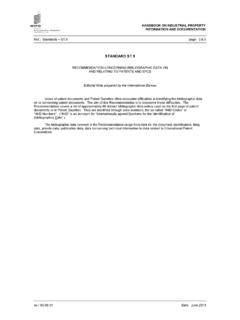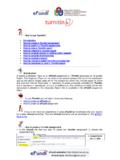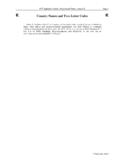Transcription of Reconsidering DCRM in the light of RDA: A Discussion Paper
1 Reconsidering DCRM in the light of RDA: A Discussion Paper I. Introduction The DCRM documents acknowledge both a historical and a normative relationship with AACR2. As the accepted standard for the cataloging of general materials, AACR2 rules are to be used unless there is a specific requirement relating to rare materials, as well as for parts of the record ( , name headings) that fall outside the scope of DCRM. The question on the table is whether DCRM should be revised so that relationship is to RDA instead of AACR2. Rather than discussing the differences between AACR2 and RDA, evaluating the changes that would need to be made and the issues that would need to be resolved in such a revision, this Paper suggests that we start by reviewing the statements in DCRM(B) and DCRM(S) that define the relationship with AACR2.
2 These statements are quoted in Section II below. Based on those statements, Section III of the Paper discusses a number of issues that will need to be resolved and offers a number of options for redefining the relationship between DCRM and AACR2/RDA. This Paper recommends that these issues be discussed and a tentative direction determined before undertaking a thorough analysis of the changes that would need to be made. Section IV describes in general terms some of the areas of difference between AACR2 and/or DCRM and RDA that might be relevant to the Discussion . This section is not intended as a full inventory of differences, nor a complete analysis of the ones described.
3 The intention is to give some background on the sort of decisions that we will confront if we move forward, in order to inform the Discussion on the more general issues raised in the first part of the Paper . Finally, Section V makes a number of recommendations for next steps to be undertaken. This Paper assumes that RDA will be implemented and that it will become the accepted standard for the cataloging of general materials in institutions applying DCRM. At this time, this is not a foregone conclusion; a recommendation from the national libraries on the implementation of RDA will not be announced until June 2011.
4 If the decision is not to implement RDA, then this Paper becomes moot. It is an attempt to prepare for an outcome (implementation of RDA) that is at least possible and perhaps even probable. Reconsidering DCRM in the light of RDA: A Discussion Paper 2 II. Relevant Sections of DCRM(B) and DCRM(S) DCRM(B), preface (p. 7): DCRM(B) was already well underway when work on RDA: Resource Description and Access (then called AACR3) was announced. The DCRM(B) editors briefly considered, then rejected, postposing further work until after RDA s publication. We agreed it would be unwise to delay, given the progress already made on DCRM(B) and the considerable investment to date of time, labor and money.
5 DCRM(B), introduction (p. 13): II. Relationship to other standards AACR2, ISBD(A), and other cataloging documentation As a revision of DCRB, DCRM(B) is based on AACR2 as amended by the Library of Congress Rule Interpretations (LCRI), as well as on the second edition of ISBD(A). The Library of Congress authorizes DCRM(B) as its interpretation of AACR2, 18. DCRM(B) deviates in substance from AACR2 and LCRI only when required by the particular descriptive needs of rare materials. In matters of style, presentation, wording, and subarrangement within areas, DCRM(B) follows its own conventions. Refer to AACR2 and LCRI for guidance and instructions on matters of description not covered in DCRM(B).
6 The relevant sections of AACR2 and LCRI must be consulted for rules governing name and uniform title headings to be used as access points for authors, editors, illustrators, printers, series, etc. For subject headings, numerous controlled vocabularies are available; within the United States, the subject headings of the Library of Congress are widely used. Consult classification documentation for assignment of call numbers. For genre/form headings, consult the various specialized thesauri issued by the RBMS Bibliographic Standards Committee. Terms from other authorized thesauri ( , the Art and Architecture Thesaurus) may also be used as appropriate.
7 DCRM(S), introduction (p. 12-13): II. Relationship to other standards AACR2, ISBD(A), CONSER and other cataloging documentation DCRM(S) is based on AACR2 as amended by the Library of Congress Rule Interpretations (LCRI), as well as on the second edition of ISBD(A) and on CONSER documentation. DCRM(S) deviates in substance from AACR2 and LCRI only when required by the particular descriptive needs of rare materials. In matters of style, presentation, wording, and subarrangement within areas, DCRM(S) follows its own conventions. [2nd paragraph same as DCRM(B)] Reconsidering DCRM in the light of RDA: A Discussion Paper 3 DCRM(B), introduction (p.)
8 17-18): Rules conform to the substance and structure of the latest revision of AACR2 to the extent possible; ISBD(A) serves as a secondary reference point This principle relates to general principles of standardization and user convenience (with the latter s subprinciple of common usage). DCRM assumes that users of bibliographic descriptions constructed in accordance with its provisions operate in contexts where AACR2 (often as interpreted and applied by the Library of Congress) is the accepted standard for the cataloging of general materials. Therefore, DCRM uses existing AACR2 vocabulary in a manner consistent with AACR2; any additional specialized vocabulary necessary for description and access of rare materials occurs in a clear and consistent manner in DCRM rules, appendixes, and glossary entries.
9 DCRM does not introduce rules that are not required by differences expected between rare and general materials. Numbering of areas within DCRM conforms to the structure of ISBD as implemented in AACR2. When an existing AACR2 rule satisfied the requirements of cataloging rare materials, DCRM text is modeled on the AACR2 text (substituting examples drawn from rare materials for illustration). In cases where the language of AACR2 is not precise enough to convey necessary distinctions or may introduce confusion when dealing with rare materials, DCRM uses carefully considered alternative wording. Wording of relevant ISBD(A) standards was also considered when deviating from AACR2.
10 [Identical provision in DCRM(S)] Note: : Choosing whether to apply AACR2 or DCRM may also need to be revised. III. Issues in these sections requiring Discussion The statements above suggest the following sets of issues requiring Discussion in the context of possible revision of the DCRM standards in the light of RDA: 1. Overall relationship between DCRM and RDA 2. Terminology used in the DCRM text 3. Structure and arrangement of DCRM standards 4. Standard for parts of the record that are not covered by DCRM 5. Relationship with ISBD(A) 6. Library of Congress policy on application of DCRM(B) Issue #1.







